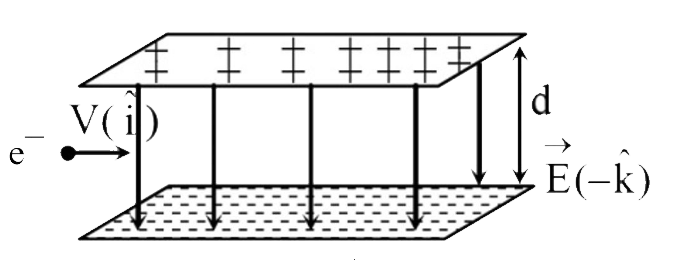In Bainbridge mass spectograph a potential difference of 1000 V is applied between two plates distant 1 cm apart and magnetic field in B=1T. The velocity of unflected positive ions in m//s from the velocity selector is
107m/s
104m/s
105m/s
102m/s
The correct Answer is:C
To find the velocity of the undeflected positive ions in a Bainbridge mass spectrograph, we can follow these steps:
Step 1: Understand the relationship between electric and magnetic forces
In the Bainbridge mass spectrograph, the electric force (Fe) acting on the ions is equal to the magnetic force (Fb) when the ions are undeflected. This can be expressed as:
Fe=Fb
Where:
- Fe=qE (Electric force)
- Fb=qvB (Magnetic force)
Step 2: Set the forces equal to each other
Since the forces are equal, we can write:
qE=qvB
We can cancel the charge q from both sides (assuming q≠0):
E=vB
Step 3: Calculate the electric field (E)
The electric field (E) between the plates can be calculated using the potential difference (V) and the distance (d) between the plates:
E=Vd
Given:
- V=1000V
- d=1cm=0.01m
Substituting the values:
E=1000V0.01m=100000V/m=105V/m
Step 4: Substitute E into the equation to find velocity (v)
Now, we can substitute E into the equation E=vB:
105=v⋅1
Thus,
v=105m/s
Final Answer
The velocity of the undeflected positive ions is:
v=100000m/s
---
In the Bainbridge mass spectrograph, the electric force (Fe) acting on the ions is equal to the magnetic force (Fb) when the ions are undeflected. This can be expressed as:
Fe=Fb
Where:
- Fe=qE (Electric force)
- Fb=qvB (Magnetic force)
Since the forces are equal, we can write:
qE=qvB
We can cancel the charge q from both sides (assuming q≠0):
E=vB
The electric field (E) between the plates can be calculated using the potential difference (V) and the distance (d) between the plates:
E=Vd
Given:
- V=1000V
- d=1cm=0.01m
E=1000V0.01m=100000V/m=105V/m
Now, we can substitute E into the equation E=vB:
105=v⋅1
Thus,
v=105m/s
The velocity of the undeflected positive ions is:
v=100000m/s
Topper's Solved these Questions
- ELECTRON, PHOTON, PHOTOELECTRIC EFFECT AND X-RAYSBOOK - ERRORLESS CHAPTER - ELECTRON, PHOTON, PHOTOELECTRIC EFFECT AND X-RAYSEXERCISE - Cathode Rays and Positive Rays
11 Videos
- ELECTRON, PHOTON, PHOTOELECTRIC EFFECT AND X-RAYSBOOK - ERRORLESS CHAPTER - ELECTRON, PHOTON, PHOTOELECTRIC EFFECT AND X-RAYSEXERCISE - Photon and Photoelectric Effect
4 Videos
- ELECTRO MAGNETIC INDUCTIONBOOK - ERRORLESS CHAPTER - ELECTRO MAGNETIC INDUCTIONEXERCISE - SET
20 Videos
- ELECTRONICSBOOK - ERRORLESS CHAPTER - ELECTRONICSEXERCISE - Selv Evaluation Test
23 Videos
Similar Questions
A particle having a charge of 1.6x10−19C enters midway between the two plates of a parallel plate capacitor. The initial velocity of particle is parallel to the plates. A potential difference of300 Vis applied between the two plates. lfthe length of the plates is 10 cm and they are separated by 2 cm, calculate the greatest initial velocity for which the particle will not be able to come out of the plates. The mass of the particle is 12×10−24kg
[104m/s]
View SolutionWhat potential difference must be applied to produce an electric field that can accelerate an electron to 1/10 of velocity of light.
View Solution
Knowledge Check
When potential difference of 9V is applied between the two plates, electron accelerate between the plates with velocity
A1.8×104m/sB1.8×106m/sC1.8×10−4m/sD1.8×10−6m/sTwo plates are 2cm apart, a potential difference of 10 volt is applied between them, the electric field between the plates is
A20N/CB500N/CC5N/CD250N/CThe parallel plate capacitor has potential difference of 100 V and separation between the plate is 1 mm. An electron is projected along x axis in between the plates. If the electron comes out of the plates along the x axis undevated then the magnitude and direction of magnetic field that must be applied between the plates : (particle is projected with a velocity of 105m/s along x axis)
 AB=1ˆk TeslaBB=1ˆj TeslaCB=1(−ˆj) TeslaDB=10(−ˆj) Tesla
AB=1ˆk TeslaBB=1ˆj TeslaCB=1(−ˆj) TeslaDB=10(−ˆj) Tesla
A beam of electrons is under the effect of potential difference of 1.36×104 volt applied across two parallel plates 4cm apart and a magnetic field of 0.002Wbm−2 at right angles to each other. If these two field produces no deflection in the beam. find the velocity of electrons. What will be radius of the orbit in which the beam will move, if the electric field is made zero ? Given, Mass of electron =9.1×10−31kg.
View SolutionAn electron is accelerated through a potential difference of 1000V and directed into space between two parallel plates separated by 2cm with a potential difference of 100V applied across them. If the electron enters perpendicular to the electric field between the polates, what magnetic field perpendicular to both the electron path and the electric field will be neccessary so that the electron may travel undeflected. Take e=1.6×10−19C and m=9×1031kg.
View SolutionElectrons are observed to be ejected in various directions with negligible speed from the negative plate of a parallel plate capacitor when the plate is illuminated by a certain wavelength. The plates are separated by a distance d and a potential difference V is maintained between them. Show that none of these electrons will reach the positive plate if a magnetic field is applied at right angles to the electric field and that the magnetic induction has a value B>(2mVed2)12 where m and e are the electron mass and charge respectively.
View SolutionAn ion of charge + g and mass m is accelerated in a region of potential difference V volts and then it enters a region of uniform magnetic field B perpendicular to its velocity. If the ion describes a semicircle of diameter x, then its mass m is
View SolutionIn a parallel capacitor the potential difference between the plates is V ,A particle of mass m and charge −Q leaves the negative plate and reaches the positive plate at distance d in time t with a momentum p .Then
View Solution
